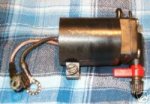halmc
Petty Officer 1st Class
- Joined
- Feb 27, 2008
- Messages
- 231
No thread highjacker, me, I decided to ask this question in a new thread.
In a current thread <http://forums.iboats.com/showthread.php?t=242166> Joe Reeves offered a step by step plan for elimination of the VRO, which included this instruction:
This really caught my eye because at some point in a '88 40 hp Evinrude's life I'm becoming aqainted with, the vro function has been eliminated. But I don't see any plugs.
In Joe's step #1, he says "cut and plug the oil line at the engine". Can either Joe or someone else be more specific about the 'oil line at the engine'.
I had my VRO off today. I noticed a quarter inch (ID) hose connecting to a fitting that runs directly into the base of the engine. I reasoned that this hose was the source of vacuum that powers the fuel pump . . . ? Is that the line Joe is talking about?
Since this engine is running as if it had a huge vacuum leak, I really got to get a handle on this issue because if that quarter inch line is sucking air in, I might be on top of my crappy running issue. Comments please!!!
In a current thread <http://forums.iboats.com/showthread.php?t=242166> Joe Reeves offered a step by step plan for elimination of the VRO, which included this instruction:
1 - Cut and plug the oil line at the engine so that the oil side of the VRO pump will not draw air into its system. Trace the wires from the back of the VRO to its rubber plug (electrical plug) and disconnect it.
This really caught my eye because at some point in a '88 40 hp Evinrude's life I'm becoming aqainted with, the vro function has been eliminated. But I don't see any plugs.
In Joe's step #1, he says "cut and plug the oil line at the engine". Can either Joe or someone else be more specific about the 'oil line at the engine'.
I had my VRO off today. I noticed a quarter inch (ID) hose connecting to a fitting that runs directly into the base of the engine. I reasoned that this hose was the source of vacuum that powers the fuel pump . . . ? Is that the line Joe is talking about?
Since this engine is running as if it had a huge vacuum leak, I really got to get a handle on this issue because if that quarter inch line is sucking air in, I might be on top of my crappy running issue. Comments please!!!






















